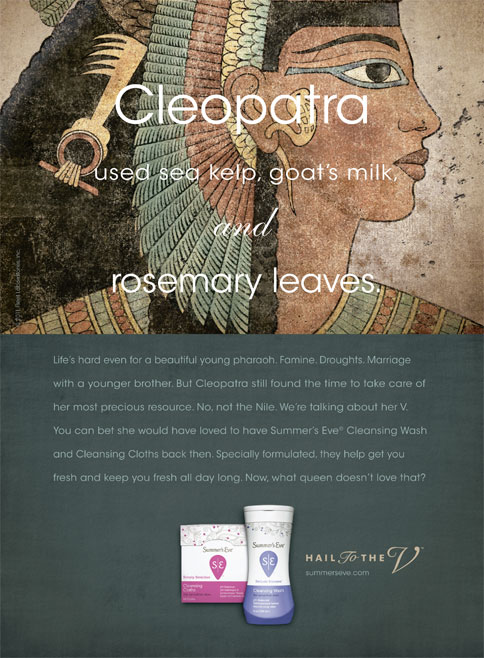
The print ad for the Summer's Eve campaign refers to the "V" but not the vagina.
If a product manufacturer or its advertising company, or both, cannot figure out which part of the female body their new line of feminine hygiene products can be used for, then both are in big trouble.
There has been much hoopla over the recently launched Summer’s Eve campaign. Links to stories about and response to the campaign can be found in my fellow blogger Elizabeth Kissling’s July 27th post. The most serious backlash to the campaign resulted in three videos perceived as “racially insensitive” being pulled from the campaign website late last week.
What rankles me about the campaign – beyond its patronizing, unsophisticated and euphemistically silly approach to the female genital area – is that it appears to target the vagina when it is clear that none of these products are actually intended for use in the vagina.
Regardless of what one might think about the value of or necessity for these femcare products, an advertising campaign for such products must convey accurate information. Like where to use them.
The product line includes: cleansing wash, cleansing cloths, deodorant spray, body powder, and bath and shower gel. Click on the OUR PRODUCTS box on the website home page and you’ll see this: Meet the products that love your vagina. Oh, really?
These products are not intended, I repeat, not intended for use in the vagina. One would think that the product manufacturer knows this. Why then did they choose a talking vagina, and across-the-board references to the vagina, to convey their product message on the website?
Interestingly, the print and TV ads hold no direct reference to the vagina. The website coyly advises viewers that they can call it “V” for short. It is this moniker and the tagline ” Hail to the V” that crosses over to print and television.
Maybe this was intended as a subtle reference to the other “V” word – vulva . It’s pretty clear this is the body part for which the Summer’s Eve products are intended.
I wanted to know why the creative team at The Richards Group, the ad company responsible for the campaign, chose to use the word vagina instead of vulva. My request for an interview to ask this question was turned down, so instead I asked two colleagues what they thought the reason might be.
Valerie Barr, veteran sexual health educator and training centre manager at Calgary Sexual Health Centre, suspects it’s because vagina is assumed to mean what is actually the vulva. She says, “I believe this assumption, or taken-for-granted use of the term, serves to avoid discussion of the clitoris and therefore, female sexual response.” Barr says she thinks it demonstrates that in our culture we continue to be unconsciously uncomfortable with women being sexual beings.
Rebecca Chalker, female anatomy expert and author of The Clitoral Truth, also believes that fear of the word clitoris has much to do with it. “Clitoris is the most toxic word in the English language, and to this day is considered obscene and too offensive to be used in the media. Just try it on people,” she says.
“Eve Ensler (author of The Vagina Monologues) made the vagina safe for the general public – even she did not use the C–word. Vagina has now become the default reference for everything ‘down there.’ Those ad guys are no different. Perhaps they’re just using the default because that’s what they think people can relate to most readily,” Chalker says.
Although vulva is the accurate word to describe the female body part intended to benefit from the Summer’s Eve product line, Chalker says, “It would be a tragedy if vulva becomes the new default. In anatomical parlance vulva just means covering.”
All of this proves that Summer’s Eve Vaginaland is a minefield, and incredibly more complex than the silly campaign would have us believe. Marketing femcare products has always been a challenge for advertisers, but that’s another story.
In deciding to pull the aforementioned videos from the campaign, Stacie Barnett, Richards Group PR Executive, told Adweek that the backlash “had begun to overshadow the message and goal of the larger campaign – to educate women about their anatomy and break down taboos in talking about it….”
Well, the educational value of the “Hail to the V” campaign is in question, and we’re still not talking about the right body part.

